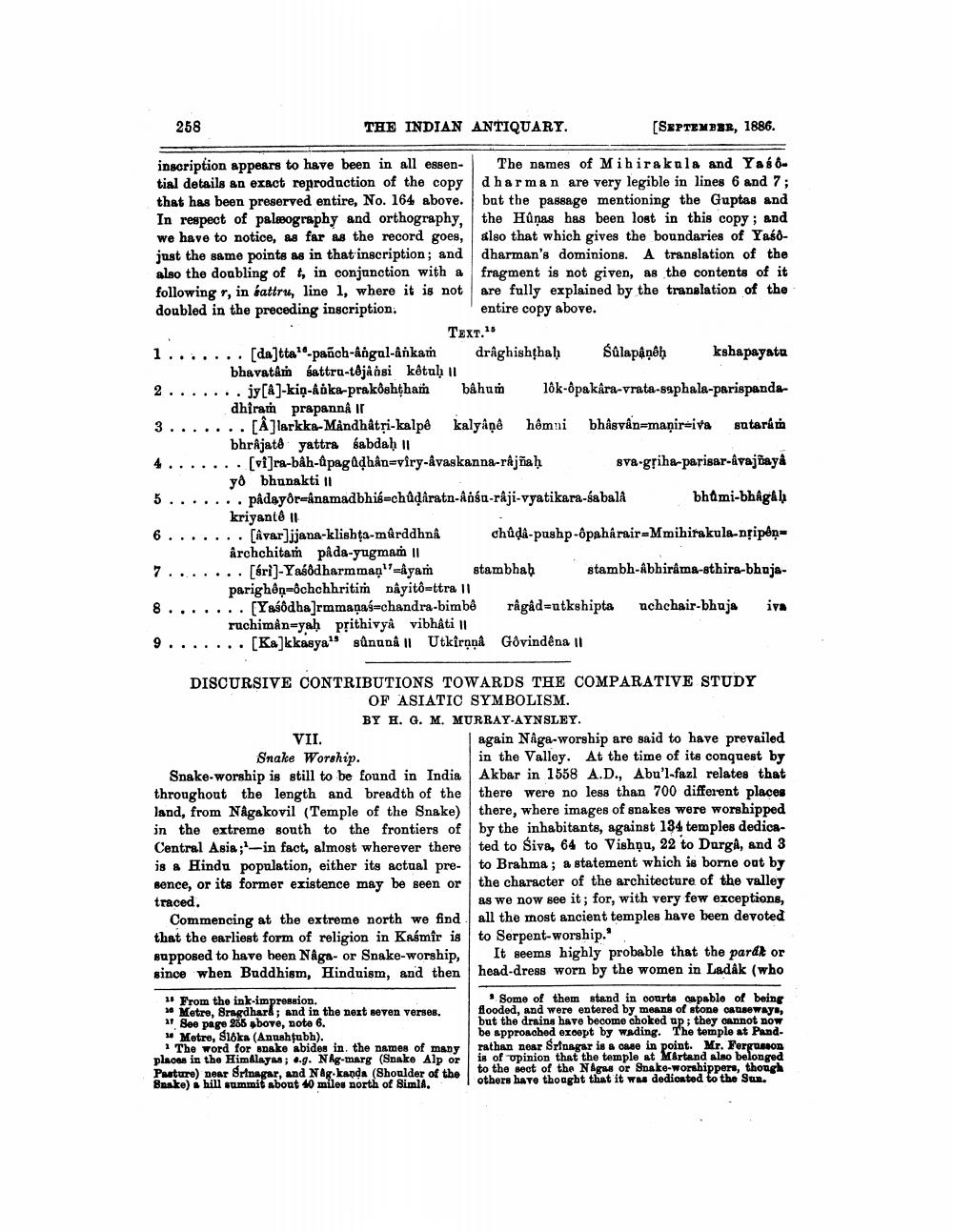________________
258
THE INDIAN ANTIQUARY.
[SEPTEMBAR, 1886.
insoription appears to have been in all essen- The names of Mihirakala and Yastial details an exact reproduction of the copy dharman are very legible in lines 6 and 7; that has been preserved entire, No. 164 above. but the passage mentioning the Guptas and In respect of palæography and orthography, the Hûnas has been lost in this copy; and we have to notice, as far as the record goes, also that which gives the boundaries of Yaśdjust the same points as in that inscription; and dharman's dominions. A translation of the also the doubling of t, in conjunction with a fragment is not given, as the contents of it following , in battru, line 1, where it is not are fully explained by the translation of the doubled in the preceding inscription:
entire copy above.
Text.15 1....... [da]tta-pañch-angalankam draghishthah Sûlapaņeh kshapayata
bhavatar sattra-tējå osi kêtuh Il 2 ....... jy[A]-kiņ&óka-prakoshtham bâhun lôk-ôpa kâra-vrata-saphala-parispanda
dhirai prapannâ Ir 3....... [A]larkka-Måndhâtri-kalpê kalyaņê hêmni bhâsvân=maņir=iva sutarán
bhrAjate yattra sabdah II .. [vi]ra-báh-ôpagląhân=viry-Âvaskanna-rajñaḥ sva-gpiha-parisar-dvajiaya
yo bhunakti II 5. ...... pâdayðræånamadbhis=chůdaratn-Ansa-råji-vyatikara-sabala bhdmi-bhagah
kriyantê 11 6 ....... (Âvar]jjana-klishta-marddhna chůda-pushp-pahárair-Mmihirakula-nțipán
årchchitam pada-yugmam 11 ... [6ri)-Yaśddharmmaņ"-ayam stambhah stambh-Abhirâma-sthira-bhoja
parighôn-chchhritim nâyitottra 11 8 .......(Yaíðdha]rmmaņas-chandra-bimbê râgâd=utkshipta uchchair-bhuja iva
ruchiman-yah prithivya vibhậti 11 9 ....... [Ka]kkasya" sūnunâ 11 Utkirạnå Govindêna II
VII.
DISCURSIVE CONTRIBUTIONS TOWARDS THE COMPARATIVE STUDY
OF ASIATIC SYMBOLISM. BY H. G. M. MURRAY-AYNSLEY.
again Naga-worship are said to have prevailed Snake Worship.
in the Valley. At the time of its conquest by Snake-worship is still to be found in India Akbar in 1558 A.D., Abu'l-fazl relates that throughout the length and breadth of the there were no less than 700 different places land, from Nagakovil (Temple of the Snake) there, where images of snakes were worshipped in the extreme south to the frontiers of by the inhabitants, against 184 temples dedicaCentral Asia; in fact, almost wherever there ted to Śive, 64 to Vishņu, 22 to Durga, and 3 is a Hindu population, either its actual pre- to Brahma; a statement which is borne out by sence, or its former existence may be seen or the character of the architecture of the valley traced.
as we now see it; for, with very few exceptions, Commencing at the extreme north we find all the most ancient temples have been devoted that the earliest form of religion in Kasmir isto Serpent-worship.' supposed to have been Någa- or Snake-worship, | It seems highly probable that the pardt or since when Buddhism, Hinduism, and then head-dress worn by the women in Ladák (who
1. From the ink-impression. * Metre, Bragdharl; and in the next seven verses. " See page 288 sbove, note 6. "Metro, Slöks (Anushţubh).
· The word for 'nako abides in the names of many plaoan in the HimAlayu; ... Nag-marg (Snake Alp or Peature) near Srinagar, and Nagkanda (Shoulder of the Brake) á hill summit about 40 miles north of SimlA.
Some of them stand in courts capable of being flooded, and were entered by means of stone causeways, but the drains have become choked up; they cannot now be approached except by wading. The temple at Pandrathan near Srinagar is a once in point. Mr. Forg.SOD is of upinion that the temple at Martand also belonged to the sect of the Nagse or Snako-worshippers, though others have thought that it was dedionted to the Sun.




